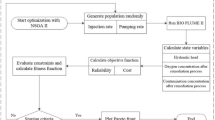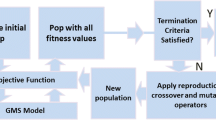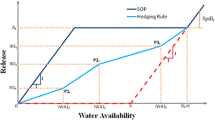Abstract
The comparison between two series of optimal remediation designs using deterministic and stochastic approaches showed a number of converging features. Limited sampling measurements in a supposed contaminated aquifer formed the hydraulic conductivity field and the initial concentration distribution used in the optimization process. The deterministic and stochastic approaches employed a single simulation–optimization method and a multiple realization approach, respectively. For both approaches, the optimization model made use of a genetic algorithm. In the deterministic approach, the total cost, extraction rate, and the number of wells used increase when the design must satisfy the intensified concentration constraint. Growing the stack size in the stochastic approach also brings about same effects. In particular, the change in the selection frequency of the used extraction wells, with increasing stack size, for the stochastic approach can indicate the locations of required additional wells in the deterministic approach due to the intensified constraints. These converging features between the two approaches reveal that a deterministic optimization approach with controlled constraints is achievable enough to design reliable remediation strategies, and the results of a stochastic optimization approach are readily available to real contaminated sites.






Similar content being viewed by others
References
Aly AH, Peralta RC (1999) Optimal design of aquifer cleanup systems under uncertainty using a neural network and a genetic algorithm. Water Resour Res 35:2523–2532
Baú DA, Mayer AS (2006) Stochastic management of pump-and-treat strategies using surrogate functions. Adv Water Resour 29:1901–1917
Chan Hilton AB, Culver TB (2000) Constraint handling for genetic algorithms in optimal remediation design. J Water Resour Plann Manage 126:128–137
Feyen L, Goelick SM (2004) Reliable groundwater management in hydroecologically sensitive areas. Water Resour Res 40:W07408. doi:10.1029/2003WR003003
Feyen L, Goelick SM (2005) Framework to evaluate the worth of hydraulic conductivity data for optimal groundwater resources management in ecologically sensitive areas. Water Resour Res 41:W03019. doi:10.1029/2003WR002901
Freeze RA, Gorelick SM (1999) Convergence of stochastic optimization and decision analysis in the engineering design of aquifer remediation. Ground Water 37:934–954
Goldberg DE (1989) Genetic algorithms in search, optimization, and machine learning. Addison-Wesley, Reading
Goovaerts P (1997) Geostatistics for natural resources evaluation. Oxford University Press, New York
Gorelick SM (1983) A review of distributed parameter ground water management modeling method. Water Resour Res 19:305–319
Guan J, Aral MM (2005) Remediation system design with multiple uncertain parameters using fuzzy sets and genetic algorithm. J Hydrolog Eng 10:386–394
Harbaugh AW, McDonald MG (1996) User’s documentation for MODFLOW-96, an update to the US Geological Survey modular finite–difference ground-water flow model, US Geological Survey Open-File Report 96-485, US Geological Survey, Virginia
Huang C, Mayer AS (1997) Pump-and-treat optimization using well locations and pumping rates as decision variables. Water Resour Res 33:1001–1012
Juang K-W, Lee D-Y, Ellsworth TR (2001) Using rank-order geostatistics for spatial interpolation of highly skewed data. J Environ Qualit 30:894–903
Ko NY, Lee KK, Hyun Y (2005) Optimal groundwater remediation design of a pump and treat system considering clean-up time. Geosci J 9:23–31
Mayer AS, Kelley CT, Miller CT (2002) Optimal design for problems involving flow and transport phenomena in saturated subsurface system. Adv Water Resour 25:1233–1256
Morgan DR, Eheart JW, Valocchi AJ (1993) Aquifer remediation design under uncertainty using a new chance constrained programming technique. Water Resour Res 29:551–561
Olea RA (1999) Geostatistics for engineers and earth scientists. Kluwer Academic Publishers, Massachusetts
Pinder GF, Ricciardi K, Karatzas GP, Wobber F, Roesler G (2001) Least-cost groundwater remediation using uncertain hydrogeological information (final report). US Department of Energy, Washington
Reed PM, Ellsworth TR, Minsker BS (2004) Spatial interpolation methods for non-stationary plume data. Ground Water 42:190–202
Ren X, Minsker B (2005) Which groundwater remediation objective is better: a realistic one or simple one? J Water Res Plann Manage 131:351–361
Sawyer CS, Lin Y-F (1998) Mixed-integer chance-constrained models for ground-water remediation. J Water Res Plann Manage 124:285–294
US Environmental Protection Agency (1999) Groundwater cleanup: overview of operating experience at 28 sites. Office of Solid Waste and Emergency Response, Washington
Wagner BJ (1995) Recent advances in simulation-optimization groundwater management modeling. Review of geophysics US national report to international union of geodesy and geophysics 1991–1994:1021–1028
Wagner BJ (1999) Evaluating data worth for ground-water management under uncertainty. J Water Resour Plann Manage 125:281–288
Wagner BJ, Gorelick SM (1987) Optimal groundwater quality management under parameter uncertainty. Water Resour Res 23:1162–1174
Wagner BJ, Gorelick SM (1989) Reliable aquifer remediation in the presence of spatially variable hydraulic conductivity: from data to design. Water Resour Res 25:2211–2225
Wang M, Zheng C (1997) Optimal remediation policy selection under general condition. Ground Water 35:757–764
Watkins Jr DW, McKinney DC (1997) Finding robust solutions to water resources problems. J Water Resour Plann Manage 123:49–58
Zheng C, Wang PP (1999) MT3DMS: a modular three-dimensional multispecies transport model for simulation of advection, dispersion, and chemical reactions of contaminants in groundwater systems: Documentation and User’s Guide, US Army Engineer Research and Development Center Contract Report SERDP-99-1, Mississippi
Zheng C, Wang PP (2002) A field demonstration of the simulation optimization approach for remediation system design. Ground Water 40:258–265
Acknowledgments
This study was supported by Advanced Environmental Biotechnology Research Center (AEBRC) at POSTECH. Sustainable Water Resources Research Center of 21st Century Frontier Research Program (# 3-4-3), and partly by Korea Energy Management Corporation (KEMCO) through KIGAM.
Author information
Authors and Affiliations
Corresponding author
Rights and permissions
About this article
Cite this article
Ko, NY., Lee, KK. Convergence of deterministic and stochastic approaches in optimal remediation design of a contaminated aquifer. Stoch Environ Res Risk Assess 23, 309–318 (2009). https://doi.org/10.1007/s00477-008-0216-8
Published:
Issue Date:
DOI: https://doi.org/10.1007/s00477-008-0216-8




